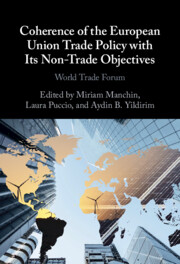Book contents
- Coherence of the European Union Trade Policy with Its Non-Trade Objectives
- Coherence of the European Union Trade Policy with Its Non-Trade Objectives
- Copyright page
- Contents
- Contributors
- Introduction
- 1 European Union Trade Policy and Non-Trade Issues
- 2 The European Union
- 3 Export Credit Agencies
- 4 The Effects of Non-Trade Provisions in Trade Agreements on Bilateral FDI
- 5 How EU Trade and Cooperation Policies Stimulated China to Go Green
- 6 The Role of Domestic Factors in the EU’s Governance of Labour Standards through Trade
- 7 EU Trade Agreements and Non-Trade Policy Objectives
- 8 Trade, the G20 and the EU
- 9 Enhancement of the European Parliament’s Monitoring for Better Coherence between Trade Policy and NTPOs
- Conclusion
- Index
- References
9 - Enhancement of the European Parliament’s Monitoring for Better Coherence between Trade Policy and NTPOs
Published online by Cambridge University Press: 19 October 2023
- Coherence of the European Union Trade Policy with Its Non-Trade Objectives
- Coherence of the European Union Trade Policy with Its Non-Trade Objectives
- Copyright page
- Contents
- Contributors
- Introduction
- 1 European Union Trade Policy and Non-Trade Issues
- 2 The European Union
- 3 Export Credit Agencies
- 4 The Effects of Non-Trade Provisions in Trade Agreements on Bilateral FDI
- 5 How EU Trade and Cooperation Policies Stimulated China to Go Green
- 6 The Role of Domestic Factors in the EU’s Governance of Labour Standards through Trade
- 7 EU Trade Agreements and Non-Trade Policy Objectives
- 8 Trade, the G20 and the EU
- 9 Enhancement of the European Parliament’s Monitoring for Better Coherence between Trade Policy and NTPOs
- Conclusion
- Index
- References
Summary
Since the Treaty of Lisbon, trade policy has become an explicit part of, and integrated into, the general framework of the EU’s external policy but must also be in conformity with internal policies. Thus, trade policy is subject to a requirement of multiple coherence. Beyond constitutional obligations, other drivers work for the inclusion of non-genuine commercial policy objectives in trade policy, such as the orientation of contemporary trade politics towards the behind-the-border issues of national regulation, so that trade policy became closely intertwined with domestic regulatory policy. Therefore the actors primarily responsible for legislation, i.e. parliaments, advocate for their extended participation in determining trade policy, and rightly so for reasons of transparency, control and political inclusiveness. Parliaments thus become actors of respect for and positive consideration of non-commercial policy objectives in trade policy, which also applies to the European Parliament (EP). Hence, an institutional design of policy formulation cycles and decision-making in EU trade policy that strives for better coherence of trade concerns with non-trade policy objectives (NTPOs) must focus on strengthening the influence of the EP and improving its participatory rights in decision-making and its control and monitoring mechanisms. Consequently, this chapter derives proposals for improving EP´s monitoring mechanisms for the benefit of NTPOs in trade policy from an analysis of weaknesses in the negotiation and implementation stage of trade policy.
Keywords
- Type
- Chapter
- Information
- Coherence of the European Union Trade Policy with Its Non-Trade ObjectivesWorld Trade Forum, pp. 236 - 262Publisher: Cambridge University PressPrint publication year: 2023



